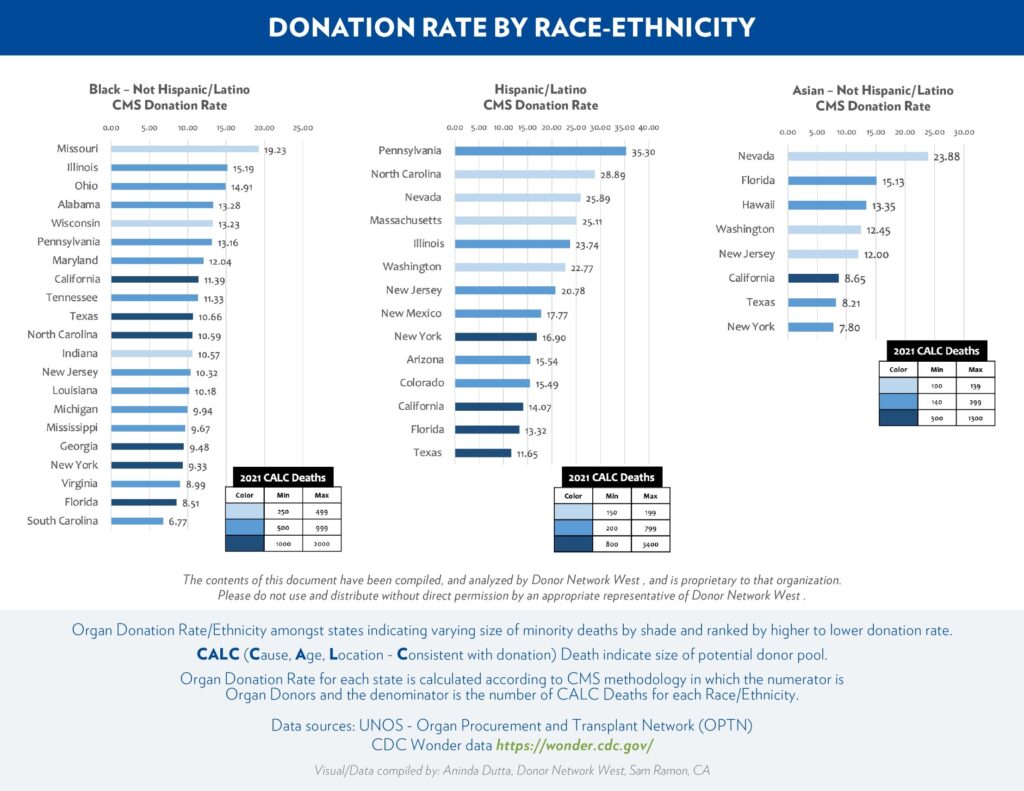Opinion: Increasing Organ Donation in the U.S. Requires Engagement from Communities of Color
Opinion by Janice Whaley, President & CEO of Donor Network West
Minorities donate. However, their rates of donation are less than those of Whites. Increasing donor authorization rates is the most significant opportunity to shorten the organ transplant waiting list. Lack of equity plagues the U.S. transplantation ecosystem and the overall healthcare system in this nation. The giving and receiving dynamic of organ transplantation and the lack of diversity, equity, and inclusion (DEI) throughout the healthcare system merit system-reform action. Minorities often do not trust the justice and equity of our country’s healthcare institutions. In the field of organ donation, addressing racial disparities forthrightly represents our greatest chance to realize the dramatic and sustained gains in organ donation needed to save more lives.
The Centers for Medicare and Medicaid Services (CMS) recently issued a regulation, which determines how OPOs, states and the nation will be measured in donation and transplantation rates. In its recent announcement, March 22, 2023, HRSA (Department of Health Resources Services Administration), laid out its plans for modernization efforts of the nation’s Organ Procurement and Transplant Network (OPTN).1 This modernization effort calls first for demographic data on organ donation which includes donation rates by race and ethnicity. Donor Network West has advocated increased OPO focus on DEI and for transparency of donation rates by race and ethnicity within the nation’s OPOs. Recent discussions with the White House Office of Domestic Policy centered on ways to increase organ donation in communities of color, along with various actions intended to strengthen regulation of and assistance to OPOs in improving minority donation rates.
Donor Network West, the OPO serving northern California and northern Nevada, has increased donation a sustained 35% for the past four years by focusing on the specific and differing needs of each community of color. Since 2018, the authorization rate has increased 83% for Black donors, Asian by 32%, Hispanic by 29% and White by 22%. For the first time, minority donors were greater than White donors were in 2021 and 2022, a trend that will only continue based on changing racial and ethnic population.
The graph reveals the large variation both between race and ethnicities amongst states meeting the threshold for a certain base number of deaths in that race/ethnicity as indicated in the legend. The graph indicates the best and worst donation rates by race/ethnicity by state. The shading reflects the greatest density of deaths amongst the groups. By engaging communities of color, the minority donation rates shown in the graph reveal that if these rates increased to only the national median, it would mean approximately 2,000 more organs available for transplant; if increased to the top quartile as many communities have done, well over 4000 more organs would be available for transplant. The total number would be higher once states not shown and other minorities not listed were included since thresholds for inclusion were used as indicated on the graph.
The organ donation and transplant community must be diligent in increasing access to transplantation for all people, and particularly communities of color who currently and historically have endured diminished access to healthcare in general. The time is now. We need to be intentional in our equity efforts.

_______________________
1 HRSA Announces Organ Procurement and Transplantation Network Modernization Initiative, March 22, 2023. HRSA Announces Organ Procurement and Transplantation Network Modernization Initiative | HRSA
Donor Network West saves and heals lives by facilitating organ and tissue recovery for transplantation and research. Established in 1987, Donor Network West is designated and certified by the Centers for Medicare and Medicaid Services, accredited by the American Association of Tissue Banks (AATB), is a member of the Organ Donation Alliance and is an official Donate Life organization. Donor Network West is federally designated to serve 45 counties in northern California and northern Nevada, Donor Network West partners with the Department of Motor Vehicles and the state-authorized donor registries to help increase donor registration. For information, visit www.DonorNetworkWest.org and follow us on social media: @mydnwest.
Support Donor Network West
